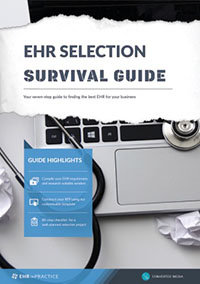4 steps to forecasting EHR software ROI
A Return on Investment (ROI), also known as a cost-benefit analysis study, must be performed before purchasing any new EHR. An EHR ROI will examine what benefits the practice will see in return for the expense of the purchase.
You can predict the ROI of a new EHR system through a series of thorough analyses.
1. Analyze and document current practice statistics, including visits and revenue
You should note your average weekly/monthly visits, average revenue per patient visit, annual revenue, unpaid claims, billing cost per claim, appointment reminders reaching your customers, cancellation and no-shows.
Reduction in missed appointments can lead to a better bottom line. A system that automates appointment reminders (texts, emails, etc) can greatly reduce the amount of missed appointments. Automated appointment reminders can reduce the percentage of cancellations and no-shows, greatly improving your revenue. Manually calling patients takes up valuable staff time that could be spent doing other important job duties.
2. Analyze your claims processing systems and timeliness of reimbursement
You should create a spreadsheet that compares date of service, date of billing, charge for services, date of reimbursement and amount reimbursed. You can take a random sampling of patients from varying insurance groups for simplicity.
Recommended reading: EHR selection survival guide - 7 steps to selecting the right EHR system
This comparison can be very eye opening. Document management efficiency in EHR may mean less time filing, faxing and searching for documentation and claims. Electronic records are more readily available for processing through billing departments and reaching insurance payers. EHR can improve revenue by allowing clinicians to instantly submit claims for billing, giving a greater return on investment. In addition, many systems capture billable treatment directly from the encounter note, so the clinician has support for any denied claims. EHR can automatically inform the office of insurance caps or visit restrictions.
3. Analyze your outgoing costs, including the cost of your new EHR system
Determine what costs the practice will incur from direct and indirect EHR processes. Most EHR systems are now run on cloud-based systems, or other secure, HIPAA compliant networks. Look into the cost of set-up, as well as the cost of purchasing hardware, maintenance agreements, training programs, support packages etc.
4. Forecast revenue changes after adoption of the new EHR system
Currently, there are incentive packages available for adopting EHR systems through meaningful use. In addition, there will be future EHR penalties for not adopting electronic documentation. For medical practices , this can have a huge impact on revenue.
Examining all aspects of costs and benefits will give you a clear indication of the financial expectations of the new system.
Determine the initial loss in productivity and then the expected increase in productivity. Once the EHR system is properly implemented, healthcare practitioners can spend less time documenting and more time treating patients. This will improve patient care and lead to more patient visits.
Examining all aspects of costs and benefits will give you a clear indication of the financial expectations of the new system. You will realize that a large initial cost will often be compensated for by increased productivity, patient visits, faster reimbursement, and compliance to federal and insurance requirements.
Free white paper

EHR Selection Survival Guide
The comprehensive guide to selecting the best EHR system for your medical practice.

Featured white papers
Related articles
-

How to conduct an EHR cost benefit analysis in six steps
A step-by-step breakdown of an EHR cost benefit analysis, and what you can learn from it
-

10 hidden costs of EHR software
Find out more about some of the hidden EHR costs that can render your budget and ROI forecasts nu...
-

Expected benefits and ROI of EHR
Quantifiable and non-quantifiable benefits and costs associated with an EHR project




